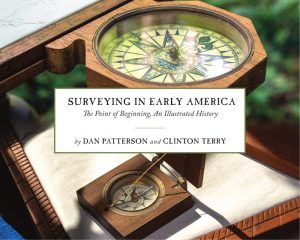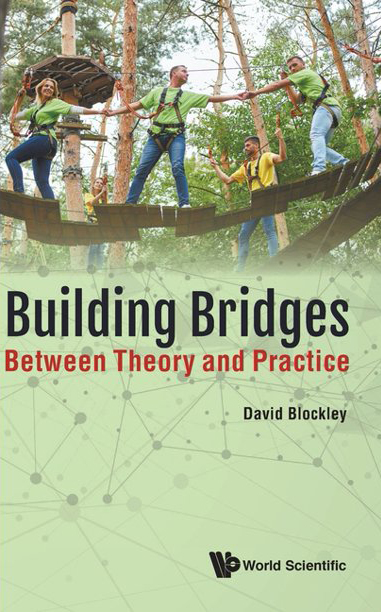One of the best ways to learn about the world is to learn from the past, and not just the successes of historical figures but their failures as well. The books reviewed today present an enjoyable perspective for each topic.
SURVEYING IN EARLY AMERICA: THE POINT OF BEGINNING, AN ILLUSTRATED HISTORY
Dan Patterson and Clinton Terry, University of Cincinnati Press, 2020, Cincinnati, OH, 113 pp., softcover ($35).
Understanding history is always better with pictures, and Surveying in Early America is an excellent example of how pictures help tell how difficult it was to survey over 250 years ago—particularly when one looks at photographs of the instruments used. In Surveying, Patterson and Terry combine their talents of description and photography to relate stories of pre-Colonial times and the application of science and engineering to perform an important service for business and society.
 Those readers who have worked at a campus with civil or technical engineering students may recall times when portions of the campus are filled by students with notebook in hand peering through a level or transit. They are learning the art and science of surveying. Recent developments have changed the tools used in surveying, but the mathematics and applications remain the same. The goal for these students is to learn the methods to describe land in verbal and graphical form, frequently for legal purposes (land ownership).
Those readers who have worked at a campus with civil or technical engineering students may recall times when portions of the campus are filled by students with notebook in hand peering through a level or transit. They are learning the art and science of surveying. Recent developments have changed the tools used in surveying, but the mathematics and applications remain the same. The goal for these students is to learn the methods to describe land in verbal and graphical form, frequently for legal purposes (land ownership).
Centuries ago, surveying could be extremely challenging. Tools had to be carried by the surveyor and had to be flexible enough to deal with both uneven terrain and heavily forested areas of the frontier. Tools for protection from the local inhabitants who didn’t appreciate the colonist’s intrusion on their land were required as well. Recreated images of the conditions early surveyors experienced fill the book and provide restored examples of the tools used. The photographs of the process demonstrate how significant the surveyor’s skills were.
While Surveying only looks at about 50 years of the practice on the new continent, chiefly using George Washington as a foil, it provides a realistic perspective of what was happening at the time. It mostly covers the period before the standard, grid-based method of surveying that laid out the Northwest Territory after 1785. As a result, it might be of greater interest to readers on the East Coast (ERAPPA and SRAPPA).
Surveying, because it is not technical, should also be of interest to a teenager contemplating a career as a surveyor or civil engineer. Regardless, it is a pleasant read that reminds us how we got here and elucidates some of the struggles associated with land development.
BUILDING BRIDGES: BETWEEN THEORY AND PRACTICE
David Blockley, World Scientific, London, 2020, 282 pp., hardcover ($84).
As one gets older, reflection on events that helped form what we do today provides perspective. Building Bridges contains a series of thoughtful reflections using examples of failures (learning experiences) to demonstrate why we engineer structures as we do today. It’s an interesting convergence of engineering and philosophy, something unusual in society these days.
 The author is an academic and may confound some who find it difficult to philosophize about engineering and learning experiences. However, his practical experience and reflections about dozens of structural engineering disasters, combined with analysis of these failures from a pragmatic perspective, provides some good reading for those who are technically inclined.
The author is an academic and may confound some who find it difficult to philosophize about engineering and learning experiences. However, his practical experience and reflections about dozens of structural engineering disasters, combined with analysis of these failures from a pragmatic perspective, provides some good reading for those who are technically inclined.
Building Bridges is not an easy read for non-civil engineers and may be difficult for non-structural engineers. It relies on some familiarity with major structural failures over the last 100 years in the United States and Europe. Bridges are the primary focus of structural failures; buildings are included as well. Why did these failures occur? The author proposes 25 different reasons, some in combinations, when looking at over 20 examples. The author ties these back to his 20 “Learning Points,” which might be compared to Stephen Covey’s 7 habits.
Buildings Bridges should not be read quickly. It is a combination of papers submitted to technical journals and proceedings, each with an extensive list of references. If one is willing to wade into the field of structural failures because of professional interest or in search of philosophical perspective, it is a great read. It has few complex equations, but it does look at Bayesian logic and systems thinking, a good way to look at any complex problem.
While Building Bridges likely has more application to a graduate engineering course, it may prove to be a valuable read for someone who wants to get away from the pressures of work while reading about other peoples’ failures—oops, learning experiences.
Ted Weidner is professor of engineering practice at Purdue University and consults on facilities management issues primarily for educational organizations. He can be reached at [email protected]. If you would like to write a book review, please contact Ted directly.
Bookshelf
Book reviews on current publications relevant to the profession, trends, and working environment of facilities and educational managers and professionals. To contribute a book review, contact Ted Weidner, field editor of this column.
See all Bookshelves.


